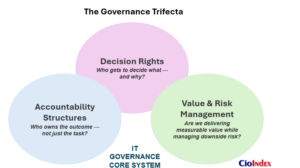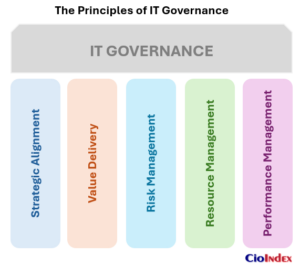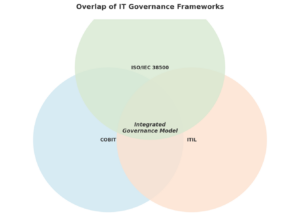Boardrooms don’t lose sleep over bad code — they lose sleep over bad decisions. And increasingly, those decisions are about technology.
Not just which systems to buy or which vendors to trust, but deeper questions: Is our digital investment building resilience or technical debt? Are we empowering innovation or enabling chaos? Who holds the steering wheel when IT becomes the engine of the business?
IT Governance is the discipline that answers these questions. Not with slogans or silver bullets, but with structure, strategy, and clarity — the kind that defines not just what gets done, but why, how, and by whom. It’s the difference between an organization that uses technology, and one that leverages it deliberately to create value, manage risk, and maintain control at scale.
If that sounds abstract, it shouldn’t. The absence of governance has a body count: failed ERP projects, compliance violations, duplicated systems, cybersecurity gaps, budgets spiraling out of control. The headlines may cite technology, but the root cause is nearly always governance — or the lack thereof.
And yet, for all its strategic importance, IT Governance often gets reduced to a set of frameworks few understand, reporting lines nobody reads, and “best practices” that never quite fit. That’s not governance. That’s theatre.
This article is not about theatre. It’s about the real foundations of IT Governance: where it came from, why it matters, what it’s made of, and how it shapes the future of digital leadership. It is written for CIOs, architects, program leads, and anyone in between who understands that controlling technology is no longer enough — you have to govern it.
For a deeper understanding on the subject you can access the CIO’s Guide on IT Governance available exclusively to subscribers.
The Evolution of IT Governance
Before IT Governance had a name, it had consequences.
In the 1990s, a major UK ambulance dispatch system failed to connect calls to ambulances, leading to fatal delays. Around the same time, a global pharmaceutical firm spent hundreds of millions on an enterprise resource planning (ERP) system — only to scrap it mid-implementation. And in the early 2000s, a wave of high-profile financial scandals (think Enron, WorldCom, Parmalat) exposed a deeper sickness: not just fraud, but the systemic failure to oversee how information — and the technology supporting it — was governed.
These weren’t technical issues. They were governance breakdowns hiding behind the camouflage of complexity.
The response? Frameworks. Standards. Acronyms. Governments, regulators, and professional bodies scrambled to define how organizations should govern their IT — not just manage it — with rigor and accountability. IT had outgrown its server rooms and slipped into the bloodstream of business. It was no longer enough to keep systems running. Now, those systems were running the business.
From Tools to Trust
Initially, IT Governance was reactive — a compliance-centric construct born out of fear. COBIT emerged in 1996, introduced by ISACA to help auditors and executives speak a common language about control objectives. ISO/IEC 38500 followed in 2008, giving corporate boards formal responsibility over IT decisions. ITIL evolved from operational checklists to service excellence frameworks.
But governance didn’t stay in the basement. As technology evolved — cloud computing, mobile, big data, cybersecurity — the stakes grew. Suddenly, IT wasn’t just enabling strategy. It was strategy. And IT Governance had to evolve too: from oversight to orchestration, from risk avoidance to value creation.
Governance in the Age of Agility
The post-2010s brought a new set of challenges. Agile delivery models disrupted traditional command-and-control structures. DevOps blurred the lines between development and operations. Shadow IT and SaaS platforms put decision-making in the hands of business units. The governance models of the early 2000s — slow, static, linear — began to look outdated.
And yet, governance didn’t die. It decentralized.
Modern IT Governance is not about forcing waterfall controls on agile teams. It’s about redefining accountability without killing speed. It’s about balancing innovation with intentionality — ensuring that fast decisions are still good decisions.
That’s why today’s IT Governance must be as dynamic as the technologies it oversees. Whether it’s ensuring ethical use of AI, navigating digital sovereignty, or enabling cross-functional cloud investments, governance is evolving from a rulebook into a radar system — scanning for value, risk, alignment, and opportunity.
What We’ve Learned
The lesson from the past three decades isn’t that we need more rules. It’s that technology without governance is risk, and governance without strategy is noise. The future belongs to organizations that govern with intent — not as a formality, but as a foundation.
Evolution of IT Governance: Key Milestones
|
Period |
Milestone |
Significance |
|
1980s |
IT functions primarily as a support service |
Minimal governance; decisions made reactively, often disconnected from strategy |
|
1990s |
Rise of enterprise systems and large-scale IT projects |
Governance challenges emerge due to complexity and increased failure rates |
|
1996 |
COBIT framework introduced by ISACA |
First formal IT Governance model focused on control objectives and auditability |
|
2000s |
Enron, WorldCom, and other scandals lead to SOX and heightened regulatory scrutiny |
Governance becomes essential for risk management and compliance |
|
2008 |
ISO/IEC 38500 released as a global standard |
Shifts governance focus to board-level strategic responsibility |
|
2010s |
Adoption of Agile, DevOps, and cloud-native architectures |
Governance adapts to decentralization, speed, and continuous delivery models |
|
2020s |
Rise of AI, ESG, data ethics, and digital sovereignty |
Governance becomes a strategic enabler focused on trust, innovation, and value |
Defining IT Governance
IT Governance isn’t a buzzword, a policy binder, or a meeting that could’ve been an email. It’s a system — one that defines how decisions about technology are made, who gets to make them, and how those decisions create value or expose risk.
At its essence, IT Governance is the framework by which organizations ensure their technology investments support business objectives, manage risk effectively, and deliver measurable performance. It’s not about micromanagement; it’s about intentionality — making sure every digital initiative has direction, accountability, and purpose.
This isn’t a luxury reserved for tech giants or public enterprises. Governance applies whether you’re a 10-person startup scaling with SaaS tools or a multinational managing data centers across five continents. The mechanisms may vary, but the core question remains universal:
“Are we using technology wisely, responsibly, and in alignment with what the business is trying to achieve?”
The Governance Trifecta: Decisions, Accountability, Value
Three pillars separate true IT Governance from technical project oversight or operational IT management:
- Decision Rights
Who makes the call — and under what conditions? IT Governance establishes clear authority lines, from architectural standards to cybersecurity policy. No more ambiguity. No more turf wars. - Accountability Structures
Governance doesn’t just assign tasks — it defines outcomes. It ensures that decisions are traceable, measured, and tied to strategic intent. It’s not about blame; it’s about clarity. - Value and Risk Management
IT initiatives are investments. Governance ensures they’re not just delivered on time and on budget, but that they generate value while managing downside exposure — technical, financial, operational, and reputational.
Governance ≠ Management
One of the most common misunderstandings — and the reason governance often gets sidelined — is the confusion between governance and management.
Governance Vs. Management
|
Governance |
Management |
|
Sets direction and defines accountability |
Executes decisions and manages operations |
|
Focused on value, risk, and alignment |
Focused on efficiency and delivery |
|
Concerned with what and why |
Concerned with how |
|
Led by senior leadership and the board |
Led by operational managers and teams |
In simple terms: Governance tells the ship where to go. Management makes sure it gets there.
Organizations that fail to distinguish between the two often end up either over-controlling their teams (stifling innovation), or under-steering their strategy (drifting into digital chaos).
IT Governance in Context
A company can have world-class engineers, bulletproof architecture, and agile sprints humming along — and still fail if those efforts are not aligned to business priorities. That’s where IT Governance comes in. It’s the connective tissue between vision and execution, policy and practice, innovation and risk.
Think of it not as a constraint, but as an operating system for decision-making. When done well, governance doesn’t slow things down. It sharpens focus. It removes waste. It aligns effort with impact.
In the next section, we’ll unpack the core principles that make governance work — not as abstract ideals, but as functional pillars that drive business-technology alignment, resource optimization, and risk intelligence.
Core Principles of IT Governance
You can’t govern well with vague intentions. You need principles — not abstract, poster-on-the-wall kind, but operational philosophies that translate strategy into action, and action into results.
Over decades of practice and refinement, IT Governance has crystallized around five core principles. These aren’t arbitrary — they’ve emerged from hard lessons, regulatory failures, and the persistent need to balance control with agility.
Each principle forms part of a larger system. Ignore one, and the rest begin to fracture.
1. Strategic Alignment
Governance begins — and often ends — with alignment. Not alignment as a one-time project, but as a dynamic, repeatable process: aligning IT initiatives with evolving business priorities, organizational capabilities, and external market shifts.
This principle forces a shift in mindset:
From “What can technology do?”
To “What should technology do to achieve our goals?”
Boards want to know whether a major platform investment will accelerate growth, reduce costs, or improve customer experience. Strategic alignment ensures that those answers are not guesses — they’re governed.
2. Value Delivery
Technology doesn’t automatically create value. IT Governance ensures that it does — by overseeing the full lifecycle of IT investments, from ideation to retirement, and demanding a clear value proposition at every stage.
Whether the project is a data warehouse, an AI-enabled chatbot, or a cybersecurity upgrade, value delivery governance asks:
- What outcomes are we targeting?
- How will we measure them?
- Who is accountable for realizing them?
If IT spend is an investment, this principle ensures the business gets a return — not just an invoice.
3. Risk Management
Every IT decision carries risk — not just technical risk, but operational, financial, reputational, and increasingly ethical. Poor governance turns these into landmines. Sound governance turns them into manageable variables.
This principle embeds risk thinking into decision-making at all levels:
- Is that third-party app secure?
- Does our data strategy comply with regulations?
- Will migrating to the cloud introduce resilience gaps?
Governance doesn’t eliminate risk. It makes risk visible, owned, and proportionate to the reward.
The Five Core Principles
|
Principle |
Description |
|
Strategic Alignment |
Ensures IT initiatives match business goals |
|
Value Delivery |
Focuses on outcomes and benefits realization |
|
Risk Management |
Identifies, mitigates, and owns risk at all levels |
|
Resource Management |
Optimizes use of IT resources (people, budget, systems) |
|
Performance Measurement |
Tracks KPIs, enables improvements, supports transparency |
4. Resource Management
IT budgets are finite. So are people, platforms, and time. Governance ensures these resources are allocated not based on the loudest department or latest trend, but on organizational priorities and performance.
This includes:
- Rationalizing redundant systems
- Prioritizing based on business cases
- Matching skills and capabilities to delivery requirements
This principle turns resource management into a strategic advantage, not a budget spreadsheet.
5. Performance Measurement
If governance is direction, and management is execution, then measurement is the mirror. You can’t improve what you can’t measure — and you can’t govern what you can’t see.
Performance measurement in IT Governance means more than uptime reports or bug counts. It’s about KPIs that track whether IT is delivering business value, reducing risk exposure, and enabling future capabilities.
Done well, it also enables:
- Real-time decision support
- Course correction based on data
- Continuous improvement across teams and initiative
Together, these five principles create a governance model that is cohesive, resilient, and responsive. They give structure to ambition, guardrails to innovation, and accountability to investment.
But principles alone aren’t enough. In the next section, we’ll look at the frameworks that operationalize these principles — the models organizations use to translate theory into working governance systems.
Frameworks That Shape IT Governance
Principles set the foundation, but frameworks build the house. They are the blueprints that help organizations structure their governance efforts — from defining roles and responsibilities to setting performance metrics, audit practices, and escalation paths.
These frameworks aren’t checklists. They are architectures of accountability, designed to adapt to different industries, maturity levels, and regulatory landscapes. While no single model fits all, the following frameworks have become foundational in shaping how organizations formalize IT Governance.
COBIT: The Governance Operating System
Originally developed by ISACA in 1996, COBIT (Control Objectives for Information and Related Technologies) has evolved into one of the most comprehensive and respected IT Governance frameworks globally.
What sets COBIT apart is its focus on the governance of enterprise IT, not just management. It helps decision-makers define who should do what, when, and how — all grounded in the principles of alignment, value, risk, and accountability.
Core strengths:
- Clear delineation between governance and management
- Tailored guidance across five governance objectives: Evaluate, Direct, Monitor, Align, and Control
- Maturity models and performance indicators built-in
COBIT is particularly useful in regulated industries or complex environments where auditability and oversight are non-negotiable.
ISO/IEC 38500: Governance at the Board Level
When the question shifts from how to govern IT to who should govern it, ISO/IEC 38500 becomes essential. Released in 2008, this international standard is explicitly designed for boards, executives, and senior decision-makers.
It provides a high-level, principle-based model that encourages boards to take responsibility for IT outcomes — something often overlooked in organizations where IT is still seen as a functional silo.
Key features:
- Six principles: Responsibility, Strategy, Acquisition, Performance, Conformance, and Human Behavior
- Focused on ethical, transparent, and effective IT decision-making
- Designed to integrate easily with other standards (e.g., ISO 27001, ISO 9001)
ISO 38500 reframes IT as a leadership issue, not just a technical one.
ITIL: Service Governance in Practice
While not a governance framework in the strictest sense, ITIL (Information Technology Infrastructure Library) plays a crucial role in governing IT service delivery. It focuses on managing the lifecycle of IT services — from design and transition to operation and continual improvement.
ITIL aligns well with governance objectives like value delivery, performance monitoring, and resource management — especially in operational contexts.
Highlights:
- Emphasis on customer-centricity and service value
- Strong in environments with high operational complexity
- Complements broader governance models like COBIT or ISO standards
In organizations where IT is heavily service-oriented, ITIL provides the execution layer beneath governance strategy.
TOGAF: Governance Through Architecture
The Open Group Architecture Framework (TOGAF) is primarily known for enterprise architecture, but it includes governance components that are often underused. TOGAF defines architecture governance as a set of practices that ensure alignment between business goals, IT strategy, and implementation.
It’s especially useful for large-scale transformation projects or in federated organizations where architecture and standards need strong alignment.
Best suited for:
- Managing architectural change at scale
- Creating governance boards to approve or adapt architectural designs
- Ensuring long-term consistency across complex IT landscapes
Picking the Right Framework (or Blending Them)
No framework is a silver bullet. Mature organizations often combine elements from multiple models — for example, using COBIT for governance structure, ITIL for operational service delivery, and ISO 38500 to align board-level oversight.
The key is to treat frameworks as tools, not templates. Governance fails when it’s too rigid to adapt or too vague to scale. The best governance systems are shaped by context, not compliance.
Comparison of Major IT Governance Frameworks
|
Framework |
Primary Focus |
Key Strengths |
Best Use Case |
Governance Level |
|
COBIT |
Comprehensive IT governance and management |
Clear distinction between governance and management; maturity models; control objectives |
Organizations needing full-spectrum IT governance, especially in regulated industries |
Strategic to operational |
|
ISO/IEC 38500 |
Board-level IT governance principles |
High-level principles for executive leadership; integrates with other ISO standards |
Executive and board-level governance and strategic alignment |
Strategic (board level) |
|
ITIL |
IT service management and delivery |
Operational excellence; customer-centric service management lifecycle |
IT departments focused on service delivery and continuous improvement |
Operational |
|
TOGAF |
Enterprise architecture governance |
Alignment of IT architecture with business goals; change governance at scale |
Large-scale enterprise transformation or federated environments |
Strategic and design/architecture |
In the next section, we’ll explore why IT Governance has become a boardroom priority — not just to check regulatory boxes, but to drive resilience, agility, and digital advantage across the enterprise.
Why IT Governance Matters More Than Ever
IT used to be a support function. Now, it’s the business engine. Every digital product, customer experience, automation initiative, or AI experiment is a strategic decision wrapped in technology. And every one of those decisions carries consequences — fiscal, reputational, operational, and in some cases, existential.
This is why IT Governance is no longer optional. It’s structural. It’s foundational. And it’s boardroom business.
Governance is what ensures that IT doesn’t just move fast — it moves in the right direction.
Technology is Now Core to Value Creation
When the majority of your customer experience, revenue channels, or product innovation is delivered digitally, IT is no longer infrastructure — it’s interface.
Whether you’re launching a new digital platform, embedding AI into core services, or scaling across geographies with cloud-native tools, governance ensures that the business case leads the technology, not the other way around.
A well-governed IT ecosystem helps organizations:
- Prioritize initiatives with strategic impact
- Avoid redundant or low-value technology spend
- Maintain continuity between innovation cycles
Without this lens, organizations risk becoming digital busybodies — active, but aimless.
Risk is No Longer Contained
The myth that cybersecurity or compliance is “an IT issue” died a long time ago. What’s emerged in its place is a sobering reality: the wrong technology decision — or the right decision, poorly governed — can unravel brand equity, trigger regulatory penalties, or expose customers to harm.
Governance is the organization’s immune system. It doesn’t prevent all attacks or failures, but it ensures that:
- Risk appetite is defined, not assumed
- Controls are proportionate and consistent
- Accountability is embedded, not outsourced
From ransomware to ethical AI to ESG reporting, IT Governance is the structure that holds the line between opportunity and overreach.
Agility Needs Accountability
Speed is the mantra of modern business. But speed without governance is a high-speed collision waiting to happen.
The rise of Agile, DevOps, low-code platforms, and cross-functional product teams has changed how IT operates — but not the need for governance. It’s just moved upstream.
Modern governance models decentralize authority without sacrificing visibility. They create spaces for experimentation, while keeping strategic guardrails intact.
What does this look like in practice?
- Empowering product teams, but holding them to measurable KPIs
- Funding innovation through governance gates, not red tape
- Embedding architecture and security reviews into the delivery lifecycle
Governance is not a brake on agility — it’s how you steer it.
Stakeholders Demand Transparency
Today’s IT ecosystem includes far more than technologists. Legal, marketing, finance, HR, product, operations — they’re all stakeholders in digital outcomes. So are regulators. So are customers.
And all of them are asking the same thing:
How do we know these decisions are smart, safe, and aligned with our purpose?
IT Governance provides the answer through:
- Transparent decision rights
- Clear accountability models
- Structured communication and reporting
This isn’t about bureaucracy — it’s about trust. And in the age of algorithmic opacity, governance builds trust where technology alone cannot.
Transformation Without Governance is Just Chaos
Digital transformation has become the most overused term in business. But behind every credible transformation lies governance — the hidden architecture of outcomes.
You can modernize platforms, digitize workflows, and embrace design thinking all day. Without governance:
- Priorities get distorted by internal politics
- Initiatives compete instead of align
- Leadership has no real line of sight into what’s working
Governance transforms transformation from hype to habit. It turns ideas into decisions, and decisions into enterprise results.
Governance is not a trend. It’s not a department. It’s the connective tissue between your digital ambition and your ability to execute on it.
In the next section, we’ll confront some of the most common misconceptions and myths that dilute or derail governance efforts — and separate real governance from symbolic compliance.
Common Misconceptions About IT Governance
If IT Governance had a publicist, they’d be horrified.
Despite its strategic value, governance is too often misunderstood, misapplied, or misbranded — dismissed as bureaucracy, delegated without authority, or implemented as a one-size-fits-all compliance checklist. These misconceptions aren’t just cosmetic. They actively weaken governance efforts, leaving organizations exposed at the exact moment they need clarity and control.
Let’s clear the fog.
Myth #1: Governance is Just Bureaucracy in Disguise
To many, the word “governance” conjures images of endless committees, approval bottlenecks, and PowerPoint presentations that say a lot but decide nothing.
But true IT Governance is not about slowing things down. It’s about making sure the right things happen, faster — with less friction, not more. Governance doesn’t introduce red tape. It removes ambiguity, aligns decision-making with strategic outcomes, and ensures that time, money, and talent are directed where they create value.
Bureaucracy is governance without intent. Real governance is intent made operational.
Myth #2: Governance Only Matters for Big, Regulated Enterprises
Yes, large enterprises and heavily regulated industries (finance, healthcare, energy) depend on governance to meet compliance requirements. But that doesn’t mean smaller or less-regulated organizations get a free pass.
In fact, lean organizations often need governance more — not less — because every misstep carries amplified risk.
Startups scaling rapidly? They need decision rights, funding prioritization, and architectural standards. Mid-sized firms entering new markets? They need data governance, vendor risk models, and aligned IT investments.
Governance scales. So does the damage from not having it.
Myth #3: Governance Slows Down Agile and DevOps
Agility and governance are not natural enemies — unless you implement one without understanding the other.
The misconception comes from old models of governance: gate-heavy, document-driven, centralized by design. But modern governance has evolved. It’s now lightweight, embedded, and adaptive.
Think of it like this:
- Agile teams decide how to build.
- Governance ensures what they’re building aligns with business goals.
- DevOps accelerates delivery.
- Governance defines acceptable risk and compliance boundaries.
The result? Speed with structure. Innovation with intention.
Myth #4: Governance Is Just for the IT Department
If IT Governance lives only within the IT department, it’s already failing.
Modern governance is cross-functional. It involves business leaders, legal, finance, operations, risk, compliance, and yes — the board. IT doesn’t own governance; it enables it.
In fact, some of the most critical governance decisions today — around data ethics, AI deployment, sustainability targets — demand input from every corner of the business. Governance works when it’s shared, not siloed.
Myth #5: Frameworks Alone Are Enough
Frameworks are important. But frameworks don’t govern — people do.
Too many organizations adopt models like COBIT, ITIL, or ISO/IEC 38500, slap the names on a few documents, and declare themselves governed. But unless those frameworks are translated into roles, rituals, incentives, and culture, they remain theater.
Governance is not what you write down. It’s what you follow through on.
Frameworks are tools. Governance is what you build with them.
By confronting these myths, organizations can unlock the real potential of IT Governance — not as a formality, but as a strategic discipline that brings order to complexity and direction to transformation.
Top Misconceptions vs. Reality
|
Myth |
Reality |
|
It’s just bureaucracy |
It removes ambiguity and accelerates value delivery |
|
Only for big companies |
Scales to startups and mid-size firms |
|
Slows down Agile |
Enables fast, accountable decision-making |
|
It’s an IT-only concern |
Requires business-wide participation |
|
Frameworks are enough |
People and culture are the real drivers |
In the next section, we’ll look at what it takes to actually get started — not with a checklist, but with a mindset: one that frames governance as a journey of strategic maturity, not just a structural box to tick.
How to Get Started with IT Governance
There is no turnkey solution to IT Governance. No app, no platform, no framework — however comprehensive — can deliver governance in a box. That’s because governance isn’t just a structure; it’s a mindset that becomes a discipline, and a discipline that becomes a culture.
Still, every mature governance model starts with the same foundational shift: from reacting to technology, to steering it.
Start with Intent, Not Templates
Many organizations begin with frameworks. Fewer begin with purpose.
Before launching a steering committee or selecting a model, ask the questions that matter:
- What decisions do we need to make better?
- What risks are we consistently underestimating?
- What outcomes are we failing to measure?
- Where is IT strategy misaligned with business direction?
Governance that’s not grounded in business context becomes performative. Governance rooted in real organizational needs becomes transformative.
Clarify Who Decides What — and Why
In most enterprises, the problem isn’t lack of expertise. It’s confusion over who owns the decision. Architecture disputes stall projects. Security concerns arise too late. Business units go rogue with shadow IT. Everyone assumes someone else is steering.
IT Governance brings clarity:
- Who decides which investments move forward?
- Who owns risk — technical, financial, reputational?
- Who ensures that innovation stays aligned with strategy?
Don’t start by redrawing org charts. Start by mapping the decisions that matter and identifying the stakeholders who must own them.
Design for Adaptability, Not Control
Governance designed like a fortress will collapse under change. Governance designed like a scaffold — supportive, flexible, iterative — will grow with the organization.
This means building:
- Principle-based policies that guide decisions without stifling them
- Governance forums that balance authority and agility
- Feedback loops that evolve governance as technology and business evolve
The best governance models are strong enough to guide, and light enough to scale.
Embed It in Culture, Not Just Process
Governance doesn’t live in handbooks or approval chains. It lives in the daily decisions teams make under pressure: when timelines shrink, when risks emerge, when trade-offs are on the table.
That’s why governance must be visible, understandable, and repeatable. It should:
- Show up in how priorities are set
- Be reflected in how performance is measured
- Inform how teams escalate, communicate, and collaborate
The end goal isn’t compliance — it’s a shared understanding of what matters and why.
Treat Governance as Strategic Infrastructure
You wouldn’t launch a new product without design or scale a system without testing. Likewise, you can’t lead in a digital economy without governance.
It’s the infrastructure that supports trust, enables speed, reduces waste, and aligns technology with ambition. Not just now — but repeatedly, sustainably, and transparently.
Don’t wait for a breach, a failure, or a mandate to start. Start with the strategic will to lead with clarity — and build governance that earns its seat at the table.
In the final section, we’ll tie together the core themes of this article, and look ahead to what IT Governance must become in the years ahead — not just as a framework, but as a competitive advantage.
For frameworks, templates, board-level governance models, and implementation roadmaps, explore our exclusive IT Governance Toolkit for subscribers.
In Conclusion
IT Governance is not a checkbox. It’s not a framework you adopt once or a policy you dust off during audits. It is a living, evolving capability — one that defines how organizations direct, evaluate, and monitor technology to achieve outcomes that matter.
What began as a response to risk and failure, has matured into a strategic necessity. From cloud migration to cybersecurity, from AI ethics to digital customer experience, the decisions organizations make about technology are now too consequential to leave ungoverned — and too complex to manage without structure.
The principles remain constant: align IT with strategy, deliver measurable value, manage risk intelligently, optimize resources, and hold performance to account.
But the execution? That must be adaptable, embedded, and owned across the business.
The future of IT Governance is not more documentation. It’s more clarity. More accountability. More purpose. It’s governance that empowers innovation, not inhibits it — that builds resilience, not resistance — and that scales trust in an increasingly algorithmic world.
Because the organizations that govern well don’t just manage technology.
They lead with it!
For those interested in a deepening their knowledge on the subject can access the CIO IT Governance Library available exclusively to subscribers.





